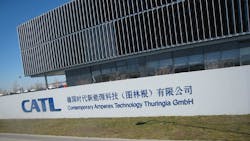CATL: New EV Battery Chemistries Driving Chinese Advances in E-Mobility Range
U.S. companies and researchers are surely working intensely on alternatives to lithium-ion battery chemistries, but electric vehicle producers are struggling in the current market where supply chains are stretched thin and impacted by tariffs and political strife.
Half the world away, a leading Chinese energy storage manufacturer, meanwhile, says it is jumping even further ahead with multiple new EV battery chemistries, capacities and state of charge on a commercial level. CATL recently unveiled three new products, including the Naxtra, which it called the world’s first mass-produced sodium-ion battery.
The other new CATL batteries are the Freevoy Dual-Power Battery and the second-generation Shenxing Superfast Charging Battery. The Naxtra reportedly has a lifespan of more than 10,000 charge cycles.
Lithium-ion chemistries currently dominate the U.S. EV battery market, but it lacks longer duration or has lesser range than other developing chemistries. An average lithium-ion EV battery, for instance, possesses only between 1,000 and 2,000 charge cycles.
The world’s biggest EV and energy storage manufacturer, CATL is banking on marketing new commercial-scale battery chemistries and charging capacity regardless of challenges such as U.S. tariffs or extreme climate conditions.
The Naxtra will be offered in both passenger EV and 24V heavy-duty start-stop battery models.
“Both are capable of performing across the full temperature range from -40 degree Celsius to +70 degrees Celsius (158 degrees Fahrenheit), redefining the extreme temperature limitations of batteries,” reads CATL’s official release about the three new battery products. “The Naxtra passenger EV Battery retains 90% usable power at -40 C. In an extremely low state of charge with only 10% state of charge remaining, the Naxtra passenger EV Battery can still achieve no significant power degradation at a temperature of -40 ℃.”
CATL boasts that its Naxtra passenger EV battery can achieve an energy density of 175 watt hours per kilogram, whereas independent reports indicate that earlier versions of sodium-ion energy density was closer to 140. Lithium iron phosphates’ energy density was around 160Wh/kg according to a 2024 report on the Automotive Manufacturing Solutions website.
The new Shenxing battery, which is made up of lithium-iron-phosphate chemistry, could range 320 miles and charge at a rate of 2.5 kilometers per second.
The impact of President Trump’s higher tariffs on many Chinese products will need to play out in global trading, but CATL already holds close to 37% of the world’s EV and energy storage battery manufacturing market share.
The U.S. Department of Defense has listed CATL as a Chinese military company. The company has 13 battery manufacturing plants, most in China but two in Germany and Hungary.
CATL’s battery technologies are used in many Asian and European EV brands, including BMW, Daimler AG, Hyundai, Honda, Toyota, Volkswagen and Volvo. Tesla also uses CATL battery cells in many of its EV models produced at Tesla’s Gigafactory in Shanghai.
Last year, the U.S. Argonne National Laboratory announced it had made a breakthrough on sodium-ion battery chemistry by changing design of the cathode.
About the Author
Rod Walton, EnergyTech Managing Editor
Managing Editor
For EnergyTech editorial inquiries, please contact Managing Editor Rod Walton at [email protected].
Rod Walton has spent 17 years covering the energy industry as a newspaper and trade journalist. He formerly was energy writer and business editor at the Tulsa World. Later, he spent six years covering the electricity power sector for Pennwell and Clarion Events. He joined Endeavor and EnergyTech in November 2021.
Walton earned his Bachelors degree in journalism from the University of Oklahoma. His career stops include the Moore American, Bartlesville Examiner-Enterprise, Wagoner Tribune and Tulsa World.
EnergyTech is focused on the mission critical and large-scale energy users and their sustainability and resiliency goals. These include the commercial and industrial sectors, as well as the military, universities, data centers and microgrids. The C&I sectors together account for close to 30 percent of greenhouse gas emissions in the U.S.
He was named Managing Editor for Microgrid Knowledge and EnergyTech starting July 1, 2023
Many large-scale energy users such as Fortune 500 companies, and mission-critical users such as military bases, universities, healthcare facilities, public safety and data centers, shifting their energy priorities to reach net-zero carbon goals within the coming decades. These include plans for renewable energy power purchase agreements, but also on-site resiliency projects such as microgrids, combined heat and power, rooftop solar, energy storage, digitalization and building efficiency upgrades.


